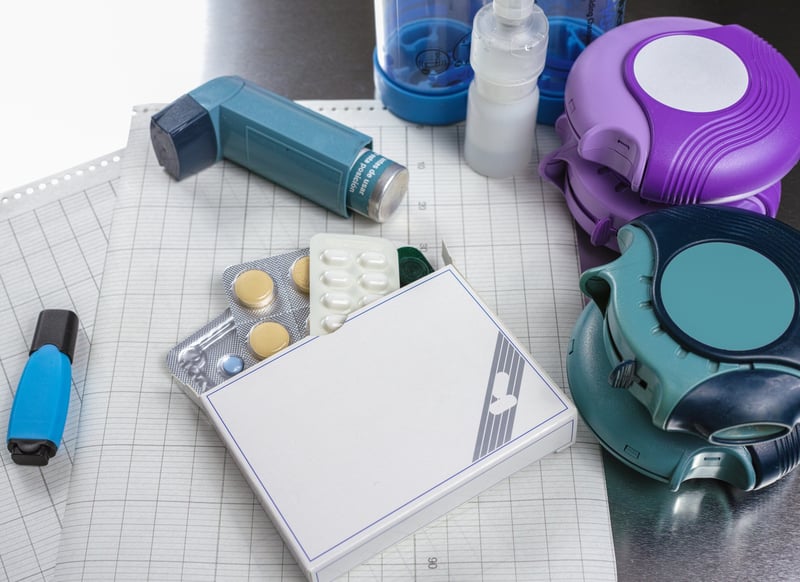Get Healthy!

- Posted May 12, 2023
Get Relief With the Most Common Asthma Medications
Receiving a diagnosis of asthma may be frightening, but learning what the treatment options are can help alleviate the anxiety that comes with diagnosis.
Depending on the severity, certain asthma medications may help you manage your symptoms. Here, experts break down the most common long-term and quick-acting medications for asthma, how they work and potential side effects.
Long-term medications
These drugs are ones the patient takes daily as a means of controlling asthma and preventing asthma attacks. These can be in pill form or used as inhalers.
Bronchodilators:
Long-acting beta-2 agonists (LABA) relax the muscle bands around your airway (bronchi), making it easier to get air in and mucus out. These medications for asthma are taken twice a day through an inhaler and last up to 12 hours, according to the Cleveland Clinic. LABA medications should be given with a corticosteroid. (See combination medications below.)
The main side effects of LABA medications are nervous or shaky feelings, hyperactivity, overexcitement, increased heart rate, upset stomach and trouble sleeping.
- Salmeterol (Serevent)
- Formoterol (Foradil)
Long-acting muscarinic antagonists (LAMA) also relax the muscle bands around your airway, the National Heart, Lung, and Blood Institute (NHLBI) says. This asthma medication is used if the steroid/LABA combination doesn't give enough relief. Do not use this medication if you have glaucoma or are at risk of urinary retention.
- Tiotropium bromide (Respimat)
Theophylline. While not used often, theophylline can be useful in relaxing the airways and preventing reactions to irritants. It is taken as a pill and used for mild asthma symptoms. You may need to have blood tests drawn on a regular basis to make sure the level of medication is correct, the Mayo Clinic says.
Side effects are the same as the other bronchodilators, but may also include chest pain or discomfort, dizziness, fainting, increase in urine volume or seizures.
- Theophylline (Theo-24, Theo-Dur, Slo-Bid, and others)
Corticosteroids:
Corticosteroids are steroids that reduce inflammation in the airways, according to the NHLBI. They may be taken as a pill, although very few patients are on the pill for long term. It is frequently used in an inhaler, often combined with a LABA.
Side effects from the inhaled form are thrush (a mouth infection) and a hoarse voice.
Inhaled corticosteroids include:
- Fluticasone (Flovent HFA, Arnuity Ellipta, others)
- Budesonide (Pulmicort Flexhaler)
- Mometasone (Asmanex Twisthaler)
- Beclomethasone (Qvar RediHaler)
- Ciclesonide (Alvesco)
Combination asthma medications (Corticosteroid and LABA):
- Fluticasone and salmeterol (Advair)
- Budesonide and formoterol (Symbicort)
- Fluticasone and Vilanterol (Breo)
Leukotriene modifiers reduce swelling and help keep your airways open for up to 24 hours. According to Mayo Clinic, these medications block the effects of leukotrienes, immune system chemicals that cause asthma symptoms.
Side effects are uncommon, but may include nausea, headache, tiredness or diarrhea.
- Montelukast (Singulair)
- Zafirlukast (Accolate)
- Zileuton (Zyflo)
Quick-acting asthma medications
These are a group of medications that are used when a patient has a flare-up or an asthma attack.
Inhaled short-acting beta2-agonists (SABAs) open the airways so air can flow through them during an asthma attack. They start working within 15 to 20 minutes and continue to work for 4 to 6 hours, according to the Cleveland Clinic.
Side effects can include tremors, rapid heartbeat, allergic reactions, muscle pain, worsening breathing, dry mouth, headache, sore throat or trouble sleeping.
Inhaled forms of SABA medications include:
- Albuterol (Ventolin)
- Levalbuterol (Xopenex)
- Albuterol and ipratropium bromide combination (DuoNeb)
Corticosteroids. Oral corticosteroids are usually prescribed for short-term use to help a patient overcome a flare-up. This type of medication quickly reduces swelling and inflammation in the airways.
Side effects include: Cataracts, osteoporosis, weight gain, high blood sugar, increased risk of infections, thinning bones and fractures, thin skin, bruising and slower wound healing, mood swings, depression and aggressive behavior.
- Prednisone (Deltasone, Prednicot, and others)
- Methylprednisolone (Medrol, Solu-Medrol, Depo-Medrol)
Short-acting anticholinergic bronchodilators help open the airways quickly. This medicine may be less effective than SABAs, but it is an option for people who experience side effects with other medications, the Cleveland Clinic says.
Side effects you may experience with these inhalers are dry throat, eyes and nose; unusual taste; nausea and vomiting; or temporary blurred vision if the medicine gets in your eyes.
- Ipratropium bromide (Atrovent)
- Tiotropium bromide (Spiriva Respimat)
Corticosteroid reliever. In January 2023, the FDA approved Airsupra, which can be used as needed to prevent bronchoconstriction and asthma attacks.
In a study conducted before the approval, the risk of severe asthma exacerbation was significantly lower with a fixed-dose combination of albuterol and budesonide than with as-needed use of albuterol alone.
Most common side effects are headache, oral yeast infection, cough, and difficulty speaking.
- Airsupra (albuterol-budesonide)




